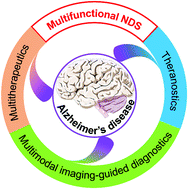Multifunctional nano-enabled delivery systems in Alzheimer's disease management
Abstract
Alzheimer's disease (AD) is the most common neurodegenerative disorder that leads to cognitive and behavioral impairment. Unfortunately, both effective diagnosis and treatment for AD remain elusive, probably owing to the complicated and uncertain etiology of the disease. To date, a number of hypotheses have been proposed that may explain AD pathogenesis, including the amyloid cascade hypothesis, the tau hypothesis, the cholinergic hypothesis, the metal ion hypothesis, the oxidative stress hypothesis and so on. Thus, the development of multifunctional compounds capable of concurrently targeting multiple pathogenic factors of AD has been suggested as an effective solution to combat this disease. Nano-enabled delivery systems (NDS) have promising potential to achieve multifunctional diagnostics/therapeutics against various targets of AD simultaneously due to the unique advantages of nanocarriers, such as easy multifunctionalization on surfaces, high surface-to-volume ratio with large payloads, and potential ability to cross the blood–brain barrier (BBB), making them capable of overcoming the limitations of traditional drug candidates. This review focuses on the recent developments of multifunctional NDS in AD management, including multitherapeutics, multimodal imaging-guided diagnostics, and theranostics. The multifunctionalization strategies, working mechanisms, and in vivo activities of the representative examples are highlighted. Finally, the opportunities and challenges of multifunctional NDS for future research are also discussed.



 Please wait while we load your content...
Please wait while we load your content...